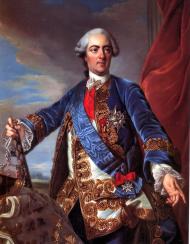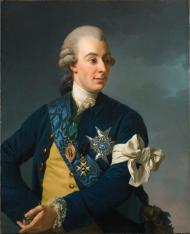Кой излиза с Marie Anne de Coislin?
Луи XV от Marie Anne de Coislin от ? до ?. Разликата във възрастта беше 22 години, 7 месеца и 2 дни.
Gustav III of Sweden от Marie Anne de Coislin от ? до ?. Разликата във възрастта беше 13 години, 4 месеца и 7 дни.
Петър III (Русия) от Marie Anne de Coislin от ? до ?. Разликата във възрастта беше 4 години, 6 месеца и 27 дни.
Marie Anne de Coislin
Marie Anne de Coislin (1732-1817), was a French aristocrat, known as the mistress to Louis XV of France in 1755. She was the king's Petite maîtresse (unofficial mistress), not his Maîtresse-en-titre (official mistress).
She was the daughter of the marquis Louis de Mailly (1696-1767) and the lady-in-waiting Anne Françoise Elisabeth Arbaleste de Melun and married in 1750 to the duke Charles Georges René du Cambout de Coislin (d. 1771), but they separated early on and she moved back with her parents.
In 1755, Louis François, Prince of Conti launched her as his candidate to replace Madame de Pompadour as official mistress of the king. She was the first serious candidate to be put up against Madame de Pompadour since Charlotte Rosalie de Choiseul-Beaupré, and she was also to be the last. She did succeed to be the secret lover of the king, which attracted some attention at court. She became known as l'altière Vasthi. Ultimately, however, the plot failed, and she was ousted from court by Madame de Pompadour. After this, there was no more serious rival to replace Madame de Pompadour, and the king mainly settled with his unofficial lovers at the Parc-aux-Cerfs.
Marie Anne de Coislin had affairs with the Prince de Conti and the count de Coigny, and was claimed to have had affairs with Christian VI of Denmark, Gustav III of Sweden and Peter III of Russia. It is unknown if these rumours where true, but Christian VI and Gustav III did visit her during their visits to Paris, which attracted attention at the time.
She did not leave France during the French Revolution, but lived as a servant in Rouen, Brittany and Vendée during the Reign of Terror. After the fall of Robespierre, she resumed her former life and property. She remarried in 1793 to Louis-Marie duc de Mailly (d. 1795).
Прочетете повече...Луи XV

Marie Anne de Coislin
Gustav III of Sweden

Gustav III (24 January [O.S. 13 January] 1746 – 29 March 1792), also called Gustavus III, was King of Sweden from 1771 until his assassination in 1792. He was the eldest son of King Adolf Frederick and Queen Louisa Ulrika of Sweden.
Gustav was a vocal opponent of what he saw as the abuse of political privileges seized by the nobility since the death of King Charles XII in the Great Northern War. Seizing power from the government in a coup d'état, called the Swedish Revolution, in 1772, that ended the Age of Liberty, he initiated a campaign to restore a measure of royal autocracy. This was completed by the Union and Security Act of 1789, which swept away most of the powers exercised by the Swedish Riksdag of the Estates during the Age of Liberty, but at the same time it opened up the government for all citizens, thereby breaking the privileges of the nobility.
A believer in enlightened absolutism, Gustav spent considerable public funds on cultural ventures, which were controversial among his critics, as well as military attempts to seize Norway with Russian aid, then a series of attempts to re-capture the Swedish Baltic dominions lost during the Great Northern War through the failed war with Russia. Nonetheless, his successful leadership in the Battle of Svensksund averted a complete military defeat and signified that Swedish military might was to be countenanced after its major defeats earlier in the century.
An admirer of Voltaire, Gustav legalised Catholic and Jewish presence in Sweden, and enacted wide-ranging reforms aimed at economic liberalism, social reform and the restriction, in many cases, of torture and capital punishment. The much-praised Freedom of the Press Act of 1766 was severely curtailed, however, by amendments in 1774 and 1792, effectively extinguishing independent media. Following the uprising against the French monarchy in 1789, Gustav pursued an alliance of princes aimed at crushing the insurrection and re-instating his French counterpart, King Louis XVI, offering Swedish military assistance as well as his leadership. In 1792 he was mortally wounded by a gunshot in the lower back during a masquerade ball as part of an aristocratic-parliamentary coup attempt, but managed to assume command and quell the uprising before succumbing to sepsis 13 days later, a period during which he received apologies from many of his political enemies. Gustav's immense powers were placed in the hands of a regency under his brother Prince Carl and Gustaf Adolf Reuterholm until his son and successor Gustav IV Adolf reached adulthood in 1796. The Gustavian autocracy thus survived until 1809, when his son was ousted in another coup d'état, which definitively established parliament as the dominant political power; this has lasted until the modern day, where the Riksdag is Sweden's supreme legislature.
A patron of the arts and benefactor of arts and literature, Gustav founded the Swedish Academy, created a national costume and had the Royal Swedish Opera and Royal Dramatic Theatre built. In 1772 he founded the Royal Order of Vasa to acknowledge and reward those Swedes who had contributed to advances in the fields of agriculture, mining and commerce. He was also a patron of many cultural figures, including Alexander Roslin and Carl Michael Bellman, and is often considered one of the most important figures in the history of Swedish art, music and architecture. Gustav III was well liked by the Swedish population and was mourned upon his death.
In 1777, Gustav III was the first formally neutral head of state in the world to recognise the United States during its war for independence from Great Britain. Swedish military forces were engaged by the thousands on the side of the colonists, largely through the French expedition force. Through the acquisition of Saint Barthélemy in 1784, Gustav enabled the restoration, if symbolic, of Swedish overseas colonies in America, as well as great personal profits from the transatlantic slave trade.
Прочетете повече...Marie Anne de Coislin
Петър III (Русия)

Петър III Фьодорович (на руски: Пётр III Фёдорович), роден Карл Петер Улрих фон Холщайн-Готорп, е император на Русия в продължение на няколко месеца през 1762 г. и основоположник на династията Холщайн-Готорп-Романов.
Известен със симпатиите си към Прусия, той сключва мир между двете страни. Свален е от власт и вероятно е убит след заговор на съпругата му Екатерина II, която заема мястото му.
Прочетете повече...